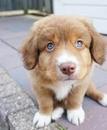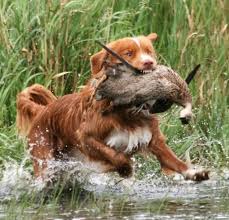Nova Scotia Duck Tolling Retriever
General
This bred originates from the Little River district of Nova Scotia and was initially called the Little River Duck Dog. The name was changed to Nova Scotia Duck Tolling Retriever, and Toller for short - this breed is comparatively rare.
The dog would toll (to lure or decoy game) by arousing curiosity}, lure, and retrieve waterfowl by playing on the edge of the water. As the waterfowl would slow down, stop or go a bit closer to see what was happening, the hunter had his gun ready. The Toller (common name for the breed)would then go and retrieve the bird.
This is the smallest of the Retriever family and was bred solely for hunting. It is often mistaken for a small Golden Retriever,their personality is not identical to other Retrievers, they are more a cross between a Retriever and a Terrier. This is an intelligent, happy, high-energy and easy to please dog that also makes a wonderful family dog.
This bred originates from the Little River district of Nova Scotia and was initially called the Little River Duck Dog. The name was changed to Nova Scotia Duck Tolling Retriever, and Toller for short - this breed is comparatively rare.
The dog would toll (to lure or decoy game) by arousing curiosity}, lure, and retrieve waterfowl by playing on the edge of the water. As the waterfowl would slow down, stop or go a bit closer to see what was happening, the hunter had his gun ready. The Toller (common name for the breed)would then go and retrieve the bird.
This is the smallest of the Retriever family and was bred solely for hunting. It is often mistaken for a small Golden Retriever,their personality is not identical to other Retrievers, they are more a cross between a Retriever and a Terrier. This is an intelligent, happy, high-energy and easy to please dog that also makes a wonderful family dog.
Is this the right dog for you?
If your looking for a coach potato - not for you! This is a working dog that needs at least an hour of exercise a day, plus somewhere to run and play, which must be fenced. Due to what the dog was bred for, a good idea to stimulate is to throw sticks and balls for it to retrieve, especially in the water - this helps to satisfy the natural instincts.
If this dog does not receive the mental and physical stimulation it needs, it will be bored and frustrated and behaviour concerns such as destructive behaviour can occur.
Overall they are friendly, but may be a bit wary when meeting new people. As with all breeds, puppy socialization should be undertaken, followed by continued socialization to put in place a solid social foundation. They are very alert dogs and will let you know if somebody is approaching your home or your car, if inside it.
In addition to hunting, they are great at agility, dock diving, and due to their intellignece, desire to work and scenting abilities, they do very well in search and rescue. If you are going to have this dog in your life, you really should find a way in which to get it to work, such as above.
They are not hard to train as love to please their owners, however, being such an independent dog, they can be stubborn. Training methods such as positive reinforcement should be used.

Should you have 2 of the same, or 2 pups together?
On average the Toller does not tend to be aggressive to other dogs, however you must make sure that your dog has been well socialized so that it will accept another dog into the home.
When it comes to which sex get on better, your best bet is one male and one female (both sterilized), or 2 males together. Never two females. The vast majority of the time two females will get on well until about 8 - 9 months of age and thenm fighting for position tends to occur. When males have the odd altercation, it tends to be over quickly, but with females, it just intensifies and often the only solution is for one of the females to be rehomes. This is not just for this breed, but in general.
Having two pups from same litter is not a good idea. Most people think that the pups will be happier with a playmate and won’t fight if they are family.Your pup should be at least 5 months old, before you consider bringing in another pup. This allows the pups to grow to their full potential and not become over dependent on one another. The truth of the matter is that your two pups are likely to:
Bond with each other to the exclusion of you
On average the Toller does not tend to be aggressive to other dogs, however you must make sure that your dog has been well socialized so that it will accept another dog into the home.
When it comes to which sex get on better, your best bet is one male and one female (both sterilized), or 2 males together. Never two females. The vast majority of the time two females will get on well until about 8 - 9 months of age and thenm fighting for position tends to occur. When males have the odd altercation, it tends to be over quickly, but with females, it just intensifies and often the only solution is for one of the females to be rehomes. This is not just for this breed, but in general.
Having two pups from same litter is not a good idea. Most people think that the pups will be happier with a playmate and won’t fight if they are family.Your pup should be at least 5 months old, before you consider bringing in another pup. This allows the pups to grow to their full potential and not become over dependent on one another. The truth of the matter is that your two pups are likely to:
Bond with each other to the exclusion of you
- Will stress without the other dog being around
- Fight with each other
- Be more destructive and boisterous
- Two pups together often leads to one being more assertive and the other more submissive. This could well end up in a situation where the more submissive dog will never develop its full potential.
- Mature later
Do they get on with other dogs?
On average yes, although they can be aggressive on occasion if they feel they are being challenged. Early socialization as a puppy and continued socialization will keep good social graces in place.
On average yes, although they can be aggressive on occasion if they feel they are being challenged. Early socialization as a puppy and continued socialization will keep good social graces in place.
Do they get on with other animals?
Although the Toller can get on well with the family cat if introduced as a puppy, due to their strong prey drive, they will chase other cats and any other small animals around.
Although the Toller can get on well with the family cat if introduced as a puppy, due to their strong prey drive, they will chase other cats and any other small animals around.
Are they good with children?
Adults are typically gentle dogs, particularly with children, however all dogs should be socialized with children of all ages from puppyhood and the socialization continued, especially for a family dog. By the same token, all children should be taught how to approach and interact with a dog and to treat it with respect.
Adults are typically gentle dogs, particularly with children, however all dogs should be socialized with children of all ages from puppyhood and the socialization continued, especially for a family dog. By the same token, all children should be taught how to approach and interact with a dog and to treat it with respect.
Health
This breed is not prone to major health concerns, however there is worry that the very small gene pool could result in hereditary diseases.The few health concerns that this dog is known to suffer from is PRA (Progressive Retinal Atrophy), and on occasion HD (Hip Dysplasia)
“In today’s age, with the rising cost of veterinary care, it really is a wise decision to consider medical insurance for your pets. Depending on the plan you choose, you can ensure that if your pet does develop one of the health issues the breed is prone too, that you will be covered –additionally, just knowing that any accident your pet may have will be covered, will out-weigh the monthly insurance fee for most pet owners. Our own personal choice is Genricpet as they have a ‘no limit’ policy and their rates are comparable to the rest of the industry. To find out the questions and things to look for in a Medical Insurance, please just follow this link”
This breed is not prone to major health concerns, however there is worry that the very small gene pool could result in hereditary diseases.The few health concerns that this dog is known to suffer from is PRA (Progressive Retinal Atrophy), and on occasion HD (Hip Dysplasia)
“In today’s age, with the rising cost of veterinary care, it really is a wise decision to consider medical insurance for your pets. Depending on the plan you choose, you can ensure that if your pet does develop one of the health issues the breed is prone too, that you will be covered –additionally, just knowing that any accident your pet may have will be covered, will out-weigh the monthly insurance fee for most pet owners. Our own personal choice is Genricpet as they have a ‘no limit’ policy and their rates are comparable to the rest of the industry. To find out the questions and things to look for in a Medical Insurance, please just follow this link”
Do’s and Dont’s
Do’s
Don’t
Do’s
- Do get your pup from a KUSA registered breeder and do read the articles on Breeders and also choosing a pup
- Sterilize at approximately 6 months of age.
- Do take your pup for socialization - pups should start at 8 weeks of age and this should not be missed - lays the foundation for future social interactions.
- Do continue the socialiazation - keeps solid social skills in place
- Give daily, regular exercise which this breed really needs.
- Supply chew toys and mental stimulation when left alone.
- Allow your dog to be part of the family
- Give regular brushing and annual vacs.
- Supply mental games such as behaviour games, scenting games etc in the garden to mentally stimulate this breed.
- Take your dog for basic training and keep simple house rules in place
Don’t
- Don't use aversive training methods.
- Leave this breed outside alone – behaviour problems will develop


